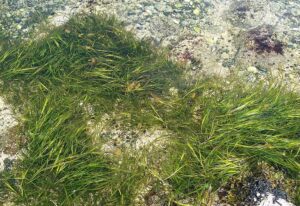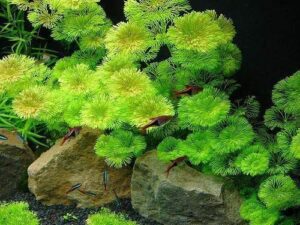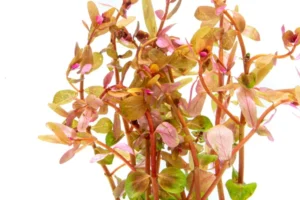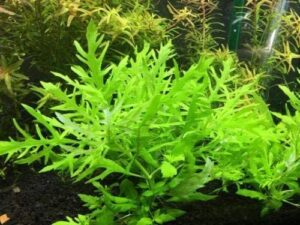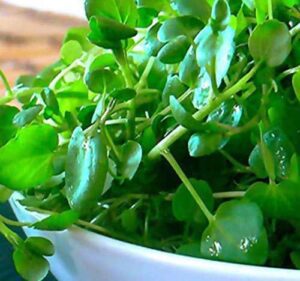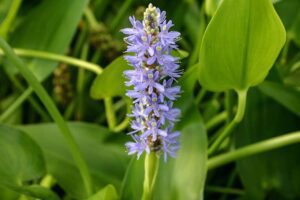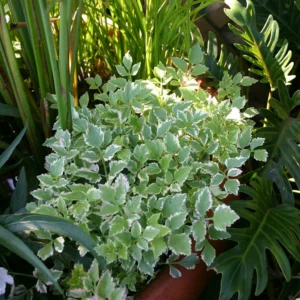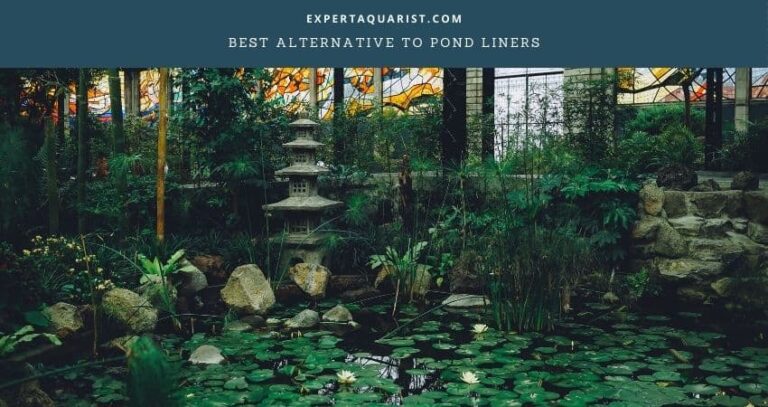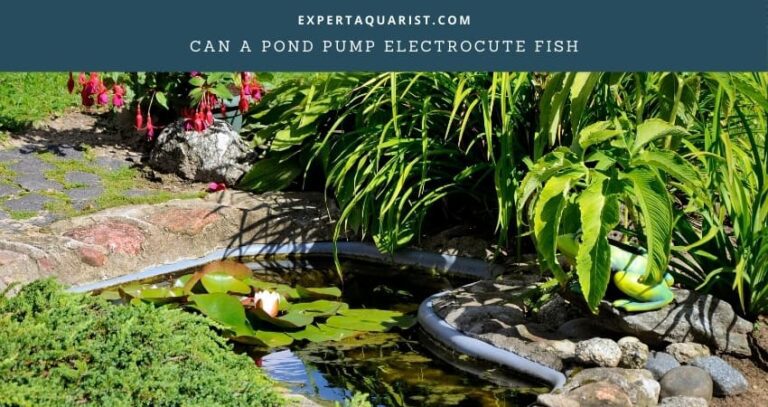Building a pond is a tough task. Taking care of it regularly is even tougher. That’s why it sucks when after all the hard work, you jeopardize everything you have done up to that point and threaten to harm the pond and its environment. Algae is one such problem.
There are tons of ways to resolve algae problems. One of the best ways to get rid of this problem is by planting aquatic plants. These plants also work great as natural water filters. Some of the best pond plants for algae control are water lilies, water lotuses, water hyacinths, Arrowhead, Hornwort, Fanwort, Red rotala, Waterweed, Water iris, Eelgrass, Water sprite, Duckweed, etc.
Let’s take a look at these plants along with some other plants and also discuss various things to consider while choosing the plants.
22 amazing plants for Algae Control
Along with fishes, plants are one of the best ways to control algae in your pond. As they are natural, they are cost-efficient while adding beauty to your pond.

They also don’t wipe out all the algae in your pond, as algae in a small amount are beneficial for the pond ecosystem. Now let’s take a look at various pond plants you can use to control algae.
1. Water Lettuce
Also called the ’Water Cabbage’, they get their name from looking like cabbages. Its leaves are large, soft, and velvety.
Water Lettuce is an excellent water purifier and can increase the quality of your pond water immensely. It can also produce offshoots from its center. As a floating plant, they also shelter the baby fish.
But this process of reproduction can cause headaches if you can’t control it. Water lettuce is sometimes called invasive species, so an uncontrolled population of them will soon take over your pond.
Also, these floating plants can block sunlight from reaching the water, which can be fatal for the fish and plants living in it. So, while having them in your pond, make sure you keep an eye on their population.
2. Water Hyacinth
Having these beautiful plants is another effective way of algae control in your pond. Although Water Hyacinth grows exponentially, they are much easier to control than algae.
Nonetheless, Water hyacinths provide an excellent filtration service to your pond. They also provide shelter for your fish from predators and the scorching sun. Their roots can also get rid of impurities. These roots can lock particles up, which makes the water free of various impurities and the water quality goes up.
Due to their rapid rate of growth, water hyacinths are sometimes called the “weeds from hell”, and they sometimes tend to block public waterways if their population is not controlled. Their maintenance is not the easiest, but when provided with the option of either having water hyacinths or algae in your pond, you will always choose hyacinths.
3. Water Lily
This is one of the most popular choices among pond owners. Water lilies have attached roots, which makes them different from other floating plants.
Known for their exquisitely beautiful flowers, which come in various colors such as white, purple, pink, red, or blue, these plants are suitable for ponds from any region and belonging to any climate.
You can plant water lilies in pots underwater, after which the flowers and the leaves will float on the water’s surface. Because of this, they provide excellent shade for fish of all ages and sizes. Lilies’ leaves also protect them from predatory birds and animals.
Water lilies are also an excellent source of filtration in your pond. They promptly get rid of algae along with any other impurities that are found in the pond.
One drawback of having water lilies in your pond is their rapid growth rate. You have to keep their population in check regularly.
4. Water Lotus
Water lotuses are sometimes mistaken as water lilies, despite having their unique characteristics. They have been cultivated for a long time for the beautification and purification of water bodies. You have an excellent chance of controlling the algae population in a pond with these.
It needs enough sunlight to grow properly, so you should opt for a shallow pot to plant it. There are various kinds of water lotuses, but the tropical types are suitable for all regions as they can grow all year long.
They have very large leaves, some even growing to 18 inches. These leaves provide shade and shelter for fish. Also, water lotuses require a lot of nutrients to grow, so the algae in the pond don’t get enough nutrients to grow uncontrollably. As a result, the algae population is always kept under control.
5. Water Iris
Water Irises are another popular choice among pond owners to beautify the pond along with purifying it. They can make your pond look breathtakingly beautiful, especially in spring.
Although the various species have some distinct characteristics, usually water irises have leaves that are sharp and long. They can come in a whole host of colors, such as white, yellow or blue.
Water Irises also don’t need full sunlight to survive as they can survive in partial sunlight as well. They should be planted in submerged pots.
Water Irises not only add beauty to your pond but have a unique ability to remove all kinds of toxins from your pond, including excessive algae. They also help to keep the pond bank stable. But this comes with a downside as well. Irises attract a lot of pests, so you should keep an eye on them.
6. Arrowhead
These oxygenating plants are sometimes also known as dwarf arrowheads or dwarf Sagittaria. Arrowheads are a highly popular choice of algae controlling plants, especially among the new pond owners.
These low-maintenance plants grow best in shallow waters. If your pond is about a couple of feet deep, then it is a perfect place for the arrowheads to grow. Looking like crabgrass clumps, these plants can grow both as submerged or partially submerged plants. They can survive in temperatures from 59 to 84 degrees Fahrenheit.
Arrowheads absorb a large number of nutrients from the pond, which prevents algae and other phytoplanktons from taking over the pond.
7. Eelgrass
Considered to be one of the best among submerged oxygenating plants, eelgrass can grow up to two feet tall in a domestic environment.
Their wild varieties can grow as tall as five feet. Eelgrass can be easily maintained, even by using hands. If you have deep ponds with large fish, they are an excellent plant to have in the pond. Eelgrass can get rid of algae in large and deep ponds easily.
8. Fanwort
They get their name from their leaves which are shaped like fans. Not only do Fanwort get rid of algae by absorbing necessary nutrients for algal bloom, but they also provide much-needed shelter for fish in the pond. Due to their fragile and delicate nature, fanworts are suitable for ponds that have small fish.
9. Hornwort
Despite looking quite delicate, these 2-feet tall plants are quite hardy. Hornworts are very versatile as they can float freely on the pond surface, as well as being anchored with some sort of weight.
They produce a good amount of dissolved oxygen and promptly get rid of algae through nutrient absorption. Hornworts can also survive in conditions that vary from time to time.
So fluctuations of light and temperature don’t hurt them that much. Hornworts are also not susceptible to being damaged by the fish. All you need to do is to keep the pH level in your pond between 6.0 and 7.5, and the plant will thrive by itself.
10. Red Rotala
An exquisitely beautiful plant, red Rotala’s robust leaves produce much-needed oxygen for the pond. But they have a lot of baggage with them.
Rotalas need a lot, and I mean a lot of things to go in their favor to be able to grow properly. The sunlight should be ample, the water should be soft, carbon dioxide should be added manually, and should have enough space so that the shade from other plants doesn’t hamper the sunlight from reaching the lower leaves of this plant.
They also need enough iron and/or phosphates in the water, which is counterproductive as phosphates also expedite the growth of algae in the pond.
11. Waterweed
Not only are water weeds an excellent oxygenating plant, but their dense leaves on stems are also pretty long to provide shelter and place for the fish to spawn. Growing waterweeds is quite easy, hence they have a penchant for taking over the pond if they are not properly maintained.
To halt their rapid growth, you have to cut some of the plants regularly. Waterweeds can grow throughout the year, making the owners worry less about the cold winter months. Although they can float on the water, waterweeds should have some sort of sediment to put their roots in.
12. Water Sprite
One kind of fern, water sprite, is an excellent water purifier. As ferns don’t have well-developed roots, they absorb all the necessary nutrients for their physiological functions directly from the pond water.
As a result, the algae population is kept under control. Water sprite can either float on the water or can be anchored down in gravel or some other kind of layer or rock two or three inches deep.
They are a versatile kind of plant that can grow in both full and partial sunlight. The ideal. pH level for their growth is 6.0 to 8.0 and the suitable temperature is 68 to 80 degrees Fahrenheit.
Water sprites grow very fast. So, you have to be careful so that they don’t overtake the pond. In case of overpopulation, the stems need to be trimmed gently.
If you pull the plants like some others on the list, their thin roots and leaves will be damaged. Also, water sprites are not suitable for being kept with goldfish because they will eat these plants.
13. Water Wisteria
A robust plant, these two feet tall and one-foot wide plants can be grown quite easily. Water Wisteria has green leaves that resemble laces and can produce beautiful blue flowers under the right circumstances.
They don’t require too much sunlight but require warmer waters. The pH level of the water should be between 6.5 and 7.5. So, they are better suited for ponds located in moderate climates.
Water wisterias also are oxygenating plants, meaning they will produce ample oxygen while preventing algae and other phytoplanktons from growing. But, they are capable of growing quite fast, so you will have to trim them regularly.
14. Duckweed
Duckweeds are excellent water filters. These small plants can grow very fast and can branch out. Duckweeds resemble lily pads with their leaves that are round, green, and small.
They can provide cover as well as some sort of shelter for the small fish in your pond. Not only that, but duckweeds can also act as fish food, which only adds to their versatility.
These floating plants require a lot of nutrients to grow. So, the algae in your pond will not be able to grow exponentially as there are not enough nutrients for them to do so.
As duckweeds grow very rapidly, you will need to trim the plants from time to time. Other than this, there isn’t much maintenance to be done. Their accelerated growth is also somewhat beneficial for the pond, as this stops the growth of algae.
15. Watercress
A regular part of South American cuisine, watercress is a very well-known plant that also doubles as fish food. So they save you some money right off the bat.
You can not plant watercress in small ponds as they can grow to a couple of feet tall and have a very high growth rate. So, you need to trim them often to prevent them from taking over the pond.
Other than the occasional trimming, you don’t need to do anything for them to thrive in your pond. Watercress can do well in both full and partial sunlight. Also, they don’t need any substrates as they are floating plants.
Like the duckweed, the watercress’s fast growth is a blessing in disguise as it doesn’t allow the algae to grow. Also, it consumes water contaminants that are responsible for murky waters.
16. Pickerel Plants
Tough and easy to maintain, pickerels are one of the best choices out there. As a proper outdoor plant, it needs ample sunlight and nutrients.
Unlike a few of the plants mentioned before it, pickerels are rooted plants, so they will need some kind of substrate which contains a lot of nutrients. But if the water has those nutrients instead of the substrate, that will also do. Their hardiness and resilience are always welcome.
Pickerels are not as efficient water filters as some other plants on this list, but their fast growth makes up for it. Because of the rapid growth, pickerels can absorb a lot of nutrients, halting the algal bloom.
The maintenance you have to do is minimal. Even the trimming is very rarely needed as they don’t grow very wide.
17. Variegated Water Celery
While not very good-looking, the variegated water celery is a great water filtering plant. Its looks resemble big ferns as they have leaves that are large and rounded.
Despite looking like large ferns, water celery grows in shallow waters. They need a kind of substrate that contains a lot of nutrients and a shallow place to facilitate their growth out of the water.
Variegated water celery can grow tall quickly, so trimming should be done frequently. There isn’t much to do maintenance-wise other than that.
Being very hardy and resilient, they suck out nutrients from the substrates, leaving very little for algae to grow. As a result, water celery becomes a very efficient filter of pond water.
18. Water Thyme
A variety of normal thyme that we regularly use for cooking, water thymes are a predominantly submerged plant. But, if they are planted in shallow waters, they can also be seen coming to the surface.
They look almost exactly like normal thyme, except for being smoother and having fewer leaves. Normal thymes don’t look so good, water thymes don’t either.
But despite how they look, water thymes are excellent water filters. They grow fast, so they need huge amounts of nutrients to do so. As a result, water thymes prevent algal bloom. Not only that, but they also consume a lot of substances that can cause problems for the pond.
Although water thymes are considered an invasive species and are somewhat unwelcome, people have found various ways to use this plant. It is mostly used in fish ponds that are situated outside.
19. Floating Fern
Floating fern is another good choice if you are looking for a plant that can filter your pond water. Looking like a mix of water lily and fern, they don’t need any substrate as they float on the surface. The only things it needs are a lot of nutrients and a good amount of sunlight. Once you ensure these two things, you don’t have to do anything else other than occasional trimming as their growth is pretty fast.
Floating ferns can also pull double duty as fish food. It also attracts insects, which can be a double-edged sword as fish can eat these insects, but too many of them will create other new problems for you. It also provides shade and shelter for the fish. Taking in huge amounts of nutrients, water ferns stop algae from growing.
20. Trapa Natans Water Chestnuts
Trapa chestnuts are a kind of floating plant. The nuts they produce help in their reproduction and are also used in Chinese cuisines.
As a floating Plant, Trapa’s leaves cover the water, providing shade and shelter for the fish in the pond. These leaves also help in preventing the growth of algae by restricting sunlight.
They don’t need that much maintenance as Trapa is a very versatile plant that can survive in either full or partial sunlight. Their growth rate is not too high as well, so you don’t need to control the population.
21. Water Crowsfoot
An oxygenating plant, Water Crowsfoot has three varieties. Two of them spread leaves over the surface of the water while the other one grows leaves underwater. It is a beautiful plant with emerald leaves and white flowers.
Crowsfoots are an excellent choice to get rid of algae as they absorb a large number of nutrients and therefore leave an inadequate amount of nutrients for the algae.
These plants can grow very fast, so you have to regularly trim them. Other than that, there isn’t much maintenance to do, to be honest. The Crowsfoot can survive in either full or partial sunlight.
22. Water Soldier
The proverb “Don’t judge a book by its cover” fits water soldier perfectly. They look very peculiar with their long, serrated leaves.
A floating plant with the roots attached to the ground, water soldiers more than make up for their weird look by very efficiently preventing algal bloom. As their leaves float in the water, it causes very limited sunlight to reach the water, which is an important factor for the growth of algae.
Aside from the removal of algae, Water soldiers’ leaves provide a very good source of shelter for the fish in the pond. They also make sure that the fish are not being harmed by the scorching sun by providing shade.
You don’t have to worry about the overpopulation of the water soldier as they have a medium growth rate. Partial or full sun is enough for their survival.
How Do Aquatic Plants for Ponds Combat Algae Growth?
Pond plants combat the growth of algae in a couple of ways. Producing oxygen, absorbing nutrients. and providing shade are the two ways that pond plants prevent algae from growing.
1. Producing oxygen and absorbing nutrients
Oxygenating plants are best when it comes to the prevention of algal bloom. These plants can grow very fast. So they need a lot of nutrients. The nitrate and phosphate nutrients in the pond are then absorbed by these oxygenating plants in a huge amount. As a result, the algae in the pond can not have access to sufficient amounts of nutrients required for an algal bloom.
One drawback of oxygenating plants is their high rate of growth or reproduction. Because of this, you need to control their population regularly.
2. Providing shade
Another way plants help to reduce algae in a pond is by providing shade. Floating plants have leaves that cover a lot of the pond’s surface. By doing this, they restrict the amount of sunlight that reaches the pond water to a minimum. As we know, sunlight is absolutely essential for the photosynthesis of algae. As floating plants don’t allow sunlight to reach the water, algae can not grow in abundance.
Why plants are a great choice for controlling algae
There are a lot of ways pond owners can get rid of the algae in their ponds. Among all these options, plants are the best.
Cost Friendly
One of the main reasons plants are better than algae removing machines is that it saves a lot of money. No matter what machine you buy, it will surely cost a lot more than the plants. Not only the buying cost, but machines also have a much larger maintenance cost than the plants, most of which only need minimal maintenance at best.
Eco-Friendly
Another advantage plants have over machines is that plants are eco-friendly. Machines produce a lot of noise and are prone to polluting the environment. On the other hand, plants are the exact opposite as they enrich the environment by producing oxygen and adding beauty. Also, machines are not always beneficial for the fish and wildlife in the pond. But plants are always beneficial for them.
Preservation of Beneficial algae
Another way plants trump the machine is by preserving beneficial algae. Machines get rid of all kinds of algae indiscriminately. But you need a minimum amount of algae in your pond for oxygen production and fish food. Plants only halt the excessive growth of the algae, they don’t actively root all the algae out of your pond.
Types of pond plants
Pond plants can be classified into four classes. All these plants are different in their anatomy, function, and growth rate. The types of pond plants are :
1. Floating Leaf Plants
Floating leaf plants are plants whose leaves float on the surface of the water while the root is attached to the bottom of the pond. The underwater part of these plants acts as nurseries for the fish as they can raise their babies in them.
Floating leaf plants are beautiful and are an integral part of a pond. They also play an important role to keep the water healthy. One of the most common examples of floating leaf plants is the Water Lily.
2. Bog Plants
Bog plants grow in the shallow waters. As a result, it is best to plant them along the pond’s edges. The ideal water depth for these plants, which are also called marginal plants, improves the quality of the water by absorbing nutrients from the soil and not allowing algae to grow. A prime example of bog plants is Rush.
3. Submerged Plants
The submerged plants are planted in pots and are kept underwater. This is where all their growth happens. They are also called oxygenating plants. The reason is that they produce much more oxygen than any other plant. Submerged plants absorb the excessive nutrients through their leaves and leave little room for algae to grow. Example: Eelgrass.
4. Prohibited Plants
These plants are prohibited because if left unchecked, they can take over any body of water in the blink of an eye. There have been cases where a single specimen of prohibited plants had caused a population boom of these plants and had caused a nuisance.
If you have these plants in your pond, make sure that you don’t discard them in public waterways. Every US state has a list of plants that are prohibited there. Before introducing a plant in your pond, check the list to see if that particular plant is prohibited or not. An example of such a plant is Water Lettuce.
What are the effects of climate and weather on the pond plants?
Not all plants can survive all kinds of climates. Some plants prefer full sunlight and warm temperatures while others prefer colder temperatures. So, while planting plants in your pond, mix plants of warm and cold seasons so that the water in your pond is well filtered throughout the year.
Usually, cool-season plants grow quickly during the earlier stages of spring while the warmer season plants grow during the summer. The algal bloom happens just before the blooming of the plants in spring and the latter stages of summer. So, it is mandatory to plan things keeping this schedule in mind.
Most common types of pond algae
There are quite a few types of algae that can grow in a pond. But the following 5 types are the most common types of algae growing in ponds.
1. Planktonic Algae
They are the most common type of algae that swim freely in your pond. Planktonic algae can be of various colors, but the most common are the green ones. The overabundance of them causes the water of your pond to turn green. Planktonic algae are unicellular.
The planktonic algae need sunlight, nutrients, and carbon dioxide for their growth and reproduction. They can obtain nutrients from various sources such as fertilizer, decaying leaves, fish waste, and fish food.
You can get rid of planktonic algae very easily. If you have a new pond, you are more likely to see them as new ponds don’t have an established ecosystem that can keep them under control. As long as there are no fish or plants as their competition for nutrients, planktonic algae will grow rapidly and take over the pond.
2. Blanketweed and String Algae
Contrary to the planktonic algae, string algae and blanketweed are multicellular. Their growth resembles that of the normal plants and they can be found on the rocks’ surfaces and pond liners.
They are the main culprits of the algal bloom. String algae float on the surface of the water in groups that look like mats. They are also known as pond scum.
The removal of string algae is quite troublesome. On one hand, UV pond clarifiers are unable to clear them properly due to their rather large size. On the other hand, clearing them by hand can result in their spores being released back into the pond, which can result in even more algae in the future.
3. Blue-green cyanobacteria
The cyanobacteria are not algae at all. In fact, they are bacteria that can not be seen with naked eyes. The only time you can see cyanobacteria is when they bloom and take on a blue-green or brown color.
They have a very unpleasant smell and are similar to pond scum or string algae in their appearance. Cyanobacteria also act like string algae in that they pollute the water by floating on the surface.
Cyanobacteria produce cyanotoxins. These toxins are extremely harmful to every kind of life, including fish, pets, livestock. and even human lives.
4. Chara Algae
Chara algae don’t look like algae at all. You will be forgiven if you mistake them for some kind of submerged plant.
As a non-flowering algae, Chara has branches and is completely submerged. It smells like garlic and has a crunchy texture.
The only bad thing about Chara is its odor. They are quite useful to have in your pond. Apart from oxygenating the pond, ducks and other animals are attracted by them.
5. Nitella algae
Nitella is quite similar to Chara algae in many ways. Both of them can be mistaken for pond plants because of their appearance and both of these plants are submerged.
But Nitella differs from Chara in their smell and texture. They don’t have any garlic-like smell and crunchy texture like Chara.
Nitella is largely harmless for your pond. They don’t act as fish food but attract insects that can be a great food source for insect-eating fish like koi.
Why are algae bad for ponds?
Algae are a fast-growing plant that needs sunlight and nutrients to grow. As most ponds have these two factors in abundance, algae can easily take over those ponds. After growing, they cover the surface of the pond, restricting sunlight that reaches the pond water.
Since the pond receives little to no sunlight, the submerged plants can not produce oxygen and the fish suffocate due to the lack of oxygen. Eventually, the fish start to die off one by one.
Not only the plant and fish lives but the equipment in the ponds are also harmed by algae. Algae are the main cause of clogging in the pond pumps and filters. This clogging results in the pumps being burnt out.
How to Add Plants to a pond
It is necessary for your pond to have sloped sides or shelves so that you can plant trees. These terraces also help the animals to get out of the water. Use the shelves to plant your plants.
You can also plant them in vegetative filters. This is an area that is adjacent to the pond and is heavily planted. The nutrients are supplied to the plants by recirculating water through this area. Make sure koi don’t get access to the pond as they love to eat them.
There are a few ways you can add plants into your pond
1. Planting in pots
The first method you can use to introduce plants into your pond is to plant them in pots and then put the pots into the water. To do this, first, you have to put the plant in a pot. It is better to use pots with holes, which will ensure the roots’ access to the nutrients in the water. Make sure to break the roots up a bit.
Then fill the pot up with planting soil. After you are done filling the pot up, put some pea gravel on top of the layer of soil. These gravels will make sure the soil doesn’t get washed away. Then put the pot on the shelf of the pond.
2. Planting directly into the pond
You can also plant the plants into your pond directly. This method requires you to create a pocket into the gravel at the bottom of your pond.
After making the pocket, take the plant and gently break the roots up a bit so that they can grow. Then put the plant into the pocket and cover the pocket with gravel.
Should I Use a Container for My Pond Plants?
Whether you should use containers for your plants depends entirely on the type of plant you are willing to have in your pond. But it will be better if your pond has a mixture of both naturally planted plants and plants that are planted in containers.
Some examples of plants that need to be kept in a container are lotus, reeds, and cattails. These containers should have no holes in them for maintenance and setting boundaries.
On the other hand, hibiscus and pickerels are shallow-water plants. They are excellent filtration plants as their root systems are huge. So it is best to plant them in baskets or geotextile bags so that they can spread their roots. To disguise the pots, try to have both tall and spreading plants within the container.
Can Anti-Algae pond plants harm the pond liner?
Different plants have different ways to be planted. Some float on the water, some need to be planted in a pot while some need to be planted in gravel.
Depending on what kind of plant you are planning to have in your pond, your pond liner will be affected.
Most plants do not damage the pond liner. But some plants like reeds have sharp tips that can cause leak in pond liners despite being covered with gravel or rocks. So it is better to keep them in a container to protect the pond liner.
Conclusion
Choosing the best pond plants for algae control is not an easy job. It requires detailed research and preparation. Only plant plants that match the size of your pond and the climate that you are living in for getting the maximum output.
But as most water filtering plants are low maintenance, once you plant them in your pond, you can bid farewell to the algae problem with relative ease.







